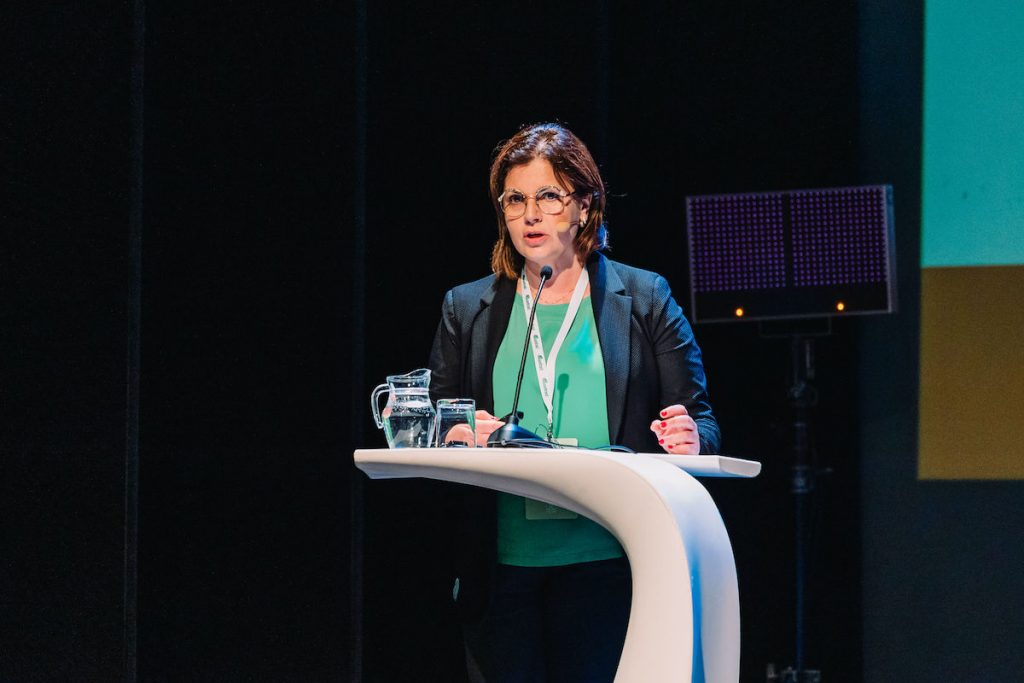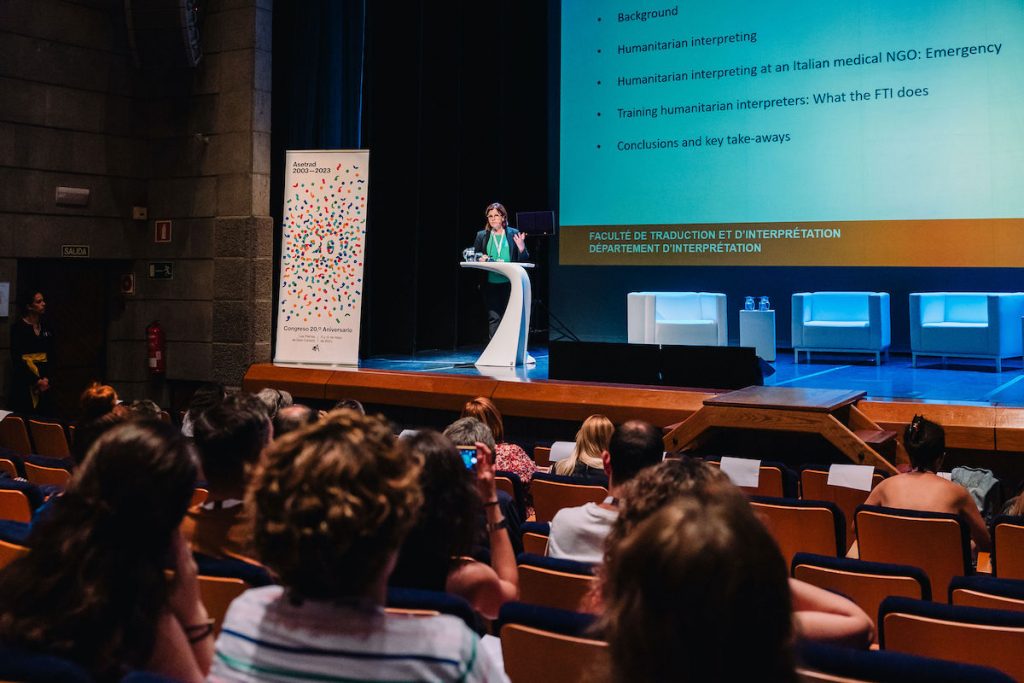
This contribution is based on a case study for an ongoing PhD research project on cultural mediators working for an Italian NGO, Emergency, which provides humanitarian aid and medical assistance in complex migration settings. Emergency’s cultural mediators carry out a wide range of tasks, including providing health and social guidance, information, and cultural mediation. The results of the study show that in being asked to perform a variety of tasks and flexibly adapt to changing circumstances the NGO’s cultural mediators are faced with major training and ethical challenges. The former concern the lack of training in areas as diverse as language, intercultural mediation, interpreting and translation, ethics, emotions, and vicarious trauma, among others. The latter refer to the cultural mediators’ scant appreciation of the ethical implications of their actions, as well as their lack of awareness in decision-making of the difference between the ethics of interpreting and the ethics of humanitarian work.
This contribution stems from a case study for an ongoing research project, and from the work carried out by the trainers in the Interpreting Department of the University of Geneva’s Faculty of Translation and Interpreting (FTI). This article is not just my brainchild: it is the result of a joint presentation between Lucía Ruiz Rosendo, who is Associate Professor and Director of the Interpreting Department at the FTI, and myself, a conference interpreter, interpreter trainer, and PhD researcher in the field of humanitarian interpreting. I had the pleasure of personally delivering this presentation on Asetrad’s 20th Anniversary in Las Palmas de Gran Canaria on 12th May 2023.
My contribution focused on the cultural mediators (CMs) who work for the Italian NGO Emergency. This NGO is known for its humanitarian work in war-torn areas around the globe.
My contribution focused on the cultural mediators (CMs) who work for the Italian NGO Emergency. This NGO is known for its humanitarian work in war-torn areas around the globe, where it aims to provide basic healthcare to civilian victims of wars and conflicts. Not everybody knows, though, that since 2006 the organization has also been active on Italian soil within the framework of its Programma Italia, within which humanitarian aid and medical assistance are provided to the poor and the vulnerable, including migrants and refugees in complex migration settings. This activity is performed in the outpatient clinics and mobile units of the NGO and is facilitated by CMs, who are hired by Emergency to carry out a wide range of tasks, including providing health and social guidance, information, cultural mediation, and interpreting to support the NGO’s Italian operations.
In this context, interpreters can rightly be said to play a major role in enabling communication, as well as in mediation and conflict resolution.
The interest in this topic stems from the fact that research into interpreting and cultural mediation in conflict and post-conflict scenarios has increased greatly in the 30 or so years since Bassnett and Lefevere’s seminal work on translation, history, and culture (Bassnett and Lefevere 1990). This has gradually led scholars of translation and interpreting studies (TIS) to research translation and interpreting (T&I) as socially situated practices, thus initiating the so-called ‘cultural turn’ in TIS. Another element to consider is the growing use of interpreters and CMs in challenging humanitarian contexts; conflicts and conflict-related scenarios, migratory flows, and natural and man-made disasters have wrought havoc in recent years, with implications at both the site of the event and in far-away areas due to increasing flows of migrants, refugees, and internally displaced people. A consequence of this has been the growing need for communication and interpreting/cultural mediation in crises and emergencies. In this context, interpreters can rightly be said to play a major role in enabling communication, as well as in mediation and conflict resolution, thus serving as all-round aid workers. This has led to the formulation of the term ‘humanitarian interpreting’, one that covers various areas of research conducted since the early 2000s within TIS to explore the role and practices of interpreters and CMs working in war and post-conflict settings and humanitarian emergencies.
Humanitarian interpreting has been investigated by various TIS researchers. Some have adopted a historical perspective, analyzing T&I practices and their evolution throughout history or in relation to a specific historical event (e.g., the whole of Jesús Baigorri-Jalón’s scholarly production, Ruiz Rosendo and Persaud 2016). Other researchers have focused on the contexts of humanitarian interpreting: the military (e.g., Inghilleri 2010; Ruiz Rosendo 2020); asylum-seeking (Inghilleri 2003; Pöllabauer 2004); NGOs (Tesseur 2018, Delgado Luchner 2018, Radicioni 2019, Montalt 2020); humanitarian aid (Delgado Luchner and Kherbiche 2018, Todorova 2016 and 2017); war reporting (Palmer 2007); or UN human rights missions (Barghout and Ruiz Rosendo 2022). Other TIS scholars, again, have addressed the relationship between migration and translation (Inghilleri 2017).
The work of interpreters and CMs in challenging humanitarian contexts is often hindered by a lack of professionalization and insufficient training.
The work of interpreters and CMs in challenging humanitarian contexts is often hindered by a lack of professionalization and insufficient training (Verrept 2019). Training is, therefore, a major issue that has often been the subject of scholarly investigation. Notable reference literature here is Federici, O’Brien, and O’Shea (2023) and Ruiz Rosendo and Todorova (2022). In this respect, TIS researchers have for example focused on several training-related aspects: learning relationships between civilian interpreters and military personnel (Tipton 2011), communities of practice (CoP) (Ruiz Rosendo 2022; Radicioni and Ruiz Rosendo 2022); the design of a training curriculum in asylum hearings (Bergunde and Pöllabauer 2019); or UN field missions (Ruiz Rosendo, Barghout, and Martin 2022).
Interpreting in the humanitarian sphere has, therefore, been researched for a good 20 years now. A definition of ‘humanitarian interpreting’ was, however, not produced until 2018. In their insightful paper on the positionality of interpreters working for the ICRC and the UNHCR, Delgado Luchner and Kherbiche (2018: 17) defined ‘humanitarian interpreting’ as
…interpreting practices that fall within the legal framework of International Humanitarian Law (IHL) and International Refugee Law and aim to enable humanitarian organizations to communicate with public authorities, and protected individuals/beneficiaries, in order to allow the latter to access their rights. Humanitarian interpreters are members of the humanitarian field (aid providers, beneficiaries, or both), who work in contexts characterized by human suffering, vulnerability, and stark power asymmetries.
In doing so, they highlighted the salient features of this interpreting mode, one that straddles several fields.
I also aimed to investigate how and to what extent this specific context impacts their work and their T&I practices.
The literature review briefly sketched above provides the context for the case study research I am currently finalizing within the framework of my PhD project at the University of Geneva, under the supervision of Lucía Ruiz Rosendo. As outlined above, in my research I am investigating the CMs working for the Italian NGO Emergency, and specifically their interpreting and cultural mediation practices in a complex migration-intense area in southern Italy, Castel Volturno (CV). In undertaking this research, my aim was to understand the context in which these CMs work and, specifically, the unique circumstances associated with CV. I also aimed to investigate how and to what extent this specific context impacts their work and their T&I practices. As an inductive and qualitative study, my research follows an emergent design, which means that the data are collected and analyzed in the field. Theory is generated from these data and not based on prior assumptions or theoretical frameworks. This study is an example of ethnographic case study research. It relies on multiple data sources, mainly semi-structured interviews and video interviews, documents, and direct observation. Data triangulation was used after data collection to corroborate findings and confirm their validity. Participants in the study were the CMs currently or previously working at the CV outpatient clinic within Emergency’s Programma Italia.
So far, several interesting findings have emerged in various fields: intercultural communication, training, ethics, ELF and interpreting/cultural mediation, and the psychological implications of interpreting/mediating in humanitarian contexts, to name but a few. In my presentation at the Asetrad Congress, I restricted the field to the training results that have so far emerged from the research.
The study has shown that the CMs currently or previously working for Emergency in CV solely received training from the organization on legal and administrative issues.
The study has generally shown that in being asked to perform a variety of tasks and flexibly adapt to changing circumstances the NGO’s CMs are faced with major training and ethical challenges. Interestingly, the study has shown that the CMs currently or previously working for Emergency in CV solely received training from the organization on legal and administrative issues. These issues are considered essential by the NGO, as CMs must be able to provide socio-medical guidance to migrant patients and, therefore, be familiar with the legal and administrative aspects of the Italian migrant reception and health systems. It emerged from the study, however, that the CMs working in CV suffer from a generalized lack of training in areas as diverse as language, interpreting, translation, (inter)cultural mediation, intercultural communication, ethics, emotions, and vicarious trauma, among others.
The study has also shown that the CMs compensate for this lack through training that they often choose to pursue on their own initiative on topics they deem interesting or useful, and by learning from their colleagues within an established CoP. This enables them to learn in the field and to learn from peers. Findings have also shown that the participants in the study have scant appreciation of the ethical implications of their actions, as well as a lack of awareness of the difference in decision-making between the ethics of interpreting and the ethics of humanitarian work.
Interpreters and mediators working in this field should be equipped with the tools to mediate in particularly sensitive contexts.
Training, therefore, seems to be one of the key issues in the humanitarian field. Interpreters and mediators working in this field should be equipped with the tools to mediate in particularly sensitive contexts and the case study illustrated above is yet another demonstration of this.
A major entity responsible for the academic training of interpreters and translators, such as the Interpreting Department of the University of Geneva’s FTI, could not ignore this plea. Against the backdrop of the increased need for linguistic mediation in conflict, post-conflict, and humanitarian zones, often provided by non-professional interpreters and translators (NPIT), the Interpreting Department of the FTI has been conducting a line of research called AXS (‘access’), which generates evidence-based data with the objective of informing training programs for interpreters working in settings at different stages of conflict progression.
This is a course jointly organized by the ICRC and the FTI to train ICRC interpreters who work in humanitarian contexts.
One training program currently underway, which was presented at the Asetrad Congress, is the FTI/ICRC Basic Consecutive Interpreting Course. This is a course jointly organized by the ICRC and the FTI to train ICRC interpreters who work in humanitarian contexts. Since the outbreak of the COVID-19 pandemic, this training —which used to be residential and last one week— has become a 4-week online program built around both synchronous and asynchronous activities. It is run 3 times per year. The trainers are all instructors working for the FTI and are all interpreter trainers, trained conference interpreters, and researchers. ICRC learners, meanwhile, perform various roles within the organization, serving for example as interpreters or FPOs. The course is provided on the FTI’s Tr@in (CANVAS) platform and comprises 1 live introductory class and 4 real-time sessions, one at the end of each week/module. As already mentioned, it lasts 4 weeks and consists of 4 modules, one per week. The course topics include an introduction to basic consecutive interpreting and note-taking (week/module 1), a focus on the ethics of interpreting in the framework of humanitarian principles and the role of the interpreter (week/module 2); assignment preparation and language enhancement (week/module 3); and interpreting and cultural mediation, with the two understood as being part of a continuum and not in opposition, the aim being to raise awareness about the cultural issues at stake in communication (week/module 4). Each module builds on the previous one, with trainees being exposed to complex interpreting interactions: turn-taking, multiple speakers, official meetings, and challenges specific to humanitarian and protection work. Participants are provided with videos and written documentation made available on the Tr@in platform. ICRC learners are required to upload their assignments to the platform by scheduled deadlines, and they receive feedback from the trainers on those assignments. After successfully submitting all assignments, course participants receive a joint attendance certificate signed by the FTI and the ICRC.
The FTI has also established a training program with the Centre of Competence on Humanitarian Negotiation (CCHN).
The FTI has also established a training program with the Centre of Competence on Humanitarian Negotiation (CCHN). The CCHN is a joint initiative of the International Committee of the Red Cross (ICRC), Médecins Sans Frontières (MSF) Switzerland, the United Nations High Commissioner for Refugees (UNHCR), the United Nations World Food Programme (WFP), and the Centre for Humanitarian Dialogue (HD). Within the framework of the FTI/CCHN program, the training provided is based on the ICRC course outlined above. It is adapted, however, to humanitarian negotiation. In this respect, it is necessary to clarify the concept of humanitarian negotiation, which is defined as
…a set of interactions between humanitarian organizations and parties to an armed conflict, as well as other relevant actors, aimed at establishing and maintaining the presence of these organizations in conflict environments, ensuring access to vulnerable groups, and facilitating the delivery of assistance and protection activities. Negotiations may involve both state and non-state actors. They include a relational component focused on building trust with the counterparts over time and a transactional component focused on determining and agreeing on the specific terms and logistics of humanitarian operations.
CCHN Digital Field Manual
Against this backdrop, the interpreter is likewise considered a negotiator, hence interpreting and negotiation are both sets of skills to be learned and which require proper training.
Another training program is currently underway between the FTI and the UN to train interpreters active in field missions.
Another training program is currently underway between the FTI and the UN to train interpreters active in field missions. The program was run in 2019 as a residential course but has now been converted into a tailored online course for staff and freelance interpreters. This is the subject of a doctoral thesis currently pursued at the FTI on the design of a mandatory online course for UN interpreters servicing field missions (Barghout, forthcoming). This course addresses themes with a wide variety of implications, among them ethics, the psychological repercussions of humanitarian interpreting, administrative and legal issues, security, and analysis of case scenarios.
What is clear, is that action needs to be taken as soon as possible and more and better training must be provided.
To conclude, the experience gained from the case study research illustrated above and the general activity of the FTI in the field of humanitarian interpreting has confirmed the need for training of interpreters working in complex humanitarian settings. This has been strongly emphasized by research, which has highlighted that greater focus should be placed on training in the field of intercultural communication. There is a pressing need to capitalize on experience and consider the dynamics of CoPs in these contexts, as training often occurs through peers and in the field and is not often provided in institutional settings. As regards filling the training gaps for interpreters and cultural mediators working in complex humanitarian contexts, there is still debate as to whether a one-size-fits-all approach or customized training is to be preferred. What is clear, is that action needs to be taken as soon as possible and more and better training must be provided. This has today become paramount, given the rise in conflict and post-conflict scenarios, emergencies, and humanitarian crises worldwide and the increasing reporting of interpreters working in said scenarios, most of whom are still unregulated and are either insufficiently trained or not trained at all.
Bibliografía
Baigorri-Jalón, J. https://scholar.google.es/citations?user=ez4U4w0AAAAJ&hl=es
Bassnett, Susan, and André Lefevere. Translation, History and Culture. London: Printer Publishers, 1990.
Barghout, A. (forthcoming). UN interpreters servicing field missions: Design of a mandatory online course. PhD thesis, FTI University of Geneva.
Bergunde, A., and S. Pöllabauer. ‘Curricular design and implementation of a training course for interpreters in an asylum context’. Translation & Interpreting 11 (1) (2019): 1–21.
CCHN Digital Field Manual. 2023. (last retrieved: 10 July 2023).
Delgado Luchner, C., and L. Kherbiche. ‘Without fear or favour? The positionality of ICRC and UNHCR interpreters in the humanitarian field’. Target 30 (3) (2018): 415–438.
Federici, F. M., O’Brien, S., and O’Shea, J. Translating and Interpreting in Crisis Settings. Training Options Report. London: CenTraS, 2023.
Inghilleri, M. ‘Habitus, field, and discourse. Interpreting as a socially situated activity’. Target 15 (2) (2003): 243–268.
Inghilleri, M. ‘You don’t make war without knowing why’. The Translator 16 (2) (2010): 175–196.
Inghilleri, M. Translation and migration. New perspectives in translation and interpreting studies. London and New York: Routledge, 2017.
Montalt, V. ‘Medical translation in crisis situations’. In Intercultural crisis communication translation, interpreting and languages in local crises, ed. F. M. Federici, and C. Declercq, 105–126. London, UK: Bloomsbury, 2020.
Palmer, J. ‘Interpreting and translation for western media in Iraq’. In Translating and interpreting conflict, ed. M. Salama-Carr, 13–28. Amsterdam: Rodopi, 2007.
Pöllabauer, S. ‘Interpreting in asylum hearings: Issues of role, responsibility, and power’. Interpreting 6 (2) (2004): 143–180.
Radicioni, M. ‘Cultural differences in interpreter-mediated medical encounters in complex humanitarian settings: The case of emergency ONG Onlus’. In Handbook of research on medical interpreting, ed. I. E. T. de V. Souza, and E. Fragkou, 165–187. Hershey, Pennsylvania: IGI Global, 2019.
Radicioni, M., and L. Ruiz Rosendo. ‘Learning dynamics between cultural mediators in humanitarian healthcare: A case study’. JosTrans 37 (2022): 139–159.
Ruiz Rosendo, L. ‘Interpreting for the military: Creating communities of practice’. JosTrans 37 (2022):16–34.
Ruiz Rosendo, L., A. Barghout, and C. Martin. ‘Interpreting on UN field missions: A training programme’. The Interpreter and Translator Trainer 15 (4) (2021): 450–467.
Ruiz Rosendo, L., and C. Persaud. ‘Interpreting in conflict zones throughout history’. Linguistica Antverpiensia 15 (2016): 1–35.
Ruiz Rosendo, L., and M. Todorova, eds. Interpreter training in conflict and post-conflict scenarios. A comparative framework. London: Palgrave, 2022.
Tipton, R. ‘Relationships of learning between military personnel and interpreters in situations of violent conflict’. The Interpreter and Translator Trainer 5 (1) (2011): 15–40.
Verrept H. What are the roles of intercultural mediators in health care and what is the evidence on their contributions and effectiveness in improving accessibility and quality of care for refugees and migrants in the WHO European Region? Copenhagen: WHO Regional Office for Europe, 2019 (Health Evidence Network (HEN) synthesis report 64).

Maura Radicioni
Maura is a PhD researcher in Interpreting Studies at the University of Geneva’s Faculty of Translation and Interpreting (FTI) conducting a study on humanitarian interpreting. She obtained her MA in Conference Interpreting from the University of Bologna, DIT at Forlì in 1997. Since then, she has worked as a conference interpreter, interpreter trainer, and researcher. Her research has been published in John Benjamins, JosTrans, BUP, and Bloomsbury, among others, as well as in edited collections, including the Handbook of Research on Medical Interpreting. She is the coeditor of Recharting Territories. Intradisciplinarity in Translation Studies, recently published by Leuven University Press. In 2017 she was involved as a trainer in the first humanitarian interpreting course in Italy, which was jointly organized by the DIT and the FTI. Since 2021, she has been one of the trainers on the basic consecutive interpreting courses held by the University of Geneva’s FTI and the ICRC.



